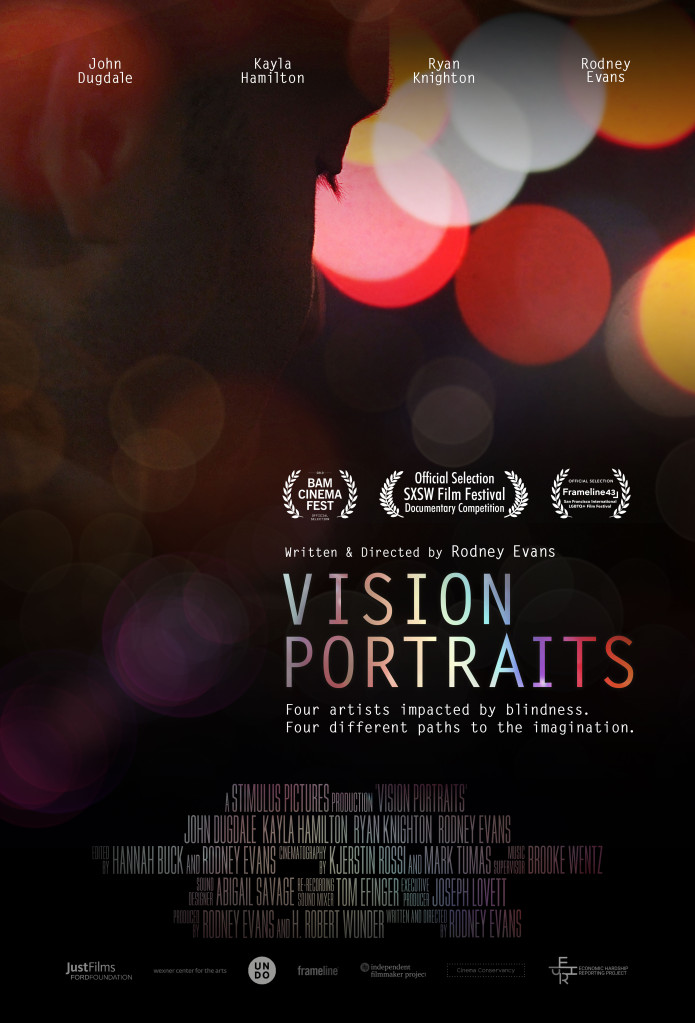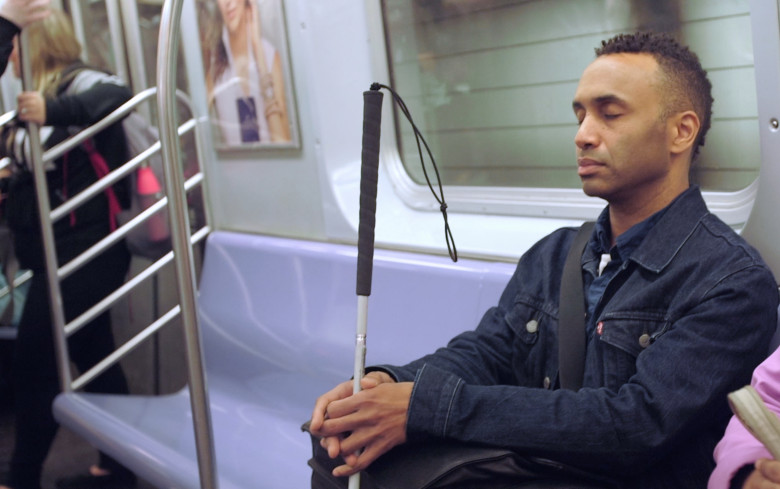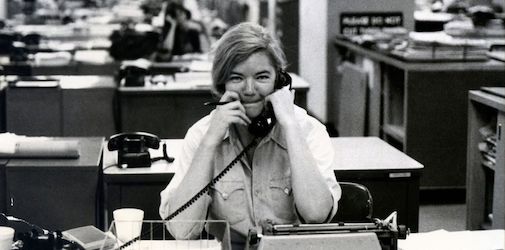By Glenn Dunks
Aware that people with vision impairments may likely read this review, I have included accessable captions underneath the images. In my day job I regularly have to work to accessibility guidelines and I think it's something we should all think about.
I’m not going to lie. There really isn’t all that much connecting the two films I’m going to talk about today other than they’re both being released around the same time and I wanted to give them some attention. And, truly, what are we even doing here if we can’t throw a wee bit of love to movies that would otherwise go completely under the radar?
 Film poster for Vision Portraits showing Rodney Evans' face against colourful lights that are out of focus.I have no doubt that Raise Hell: The Life & Times of Molly Ivins will find an appreciative audience. She was, after all, a famous writer with dedicated fans right up to her death in 2007. I am less convinced that Rodney Evans’ delicate and partly autobiographic Vision Portraits would manage the same. It’s small, you see. Small in the sense that it doesn’t call attention to itself. Small in the sense that it tells its story with grace and humanism and allows its audience to depart with a mind full of contemplation. It is a morsel of a documentary (it is 78 minutes long), but one that should open its viewers to ideas that it would otherwise likely have little reason to consider.
Film poster for Vision Portraits showing Rodney Evans' face against colourful lights that are out of focus.I have no doubt that Raise Hell: The Life & Times of Molly Ivins will find an appreciative audience. She was, after all, a famous writer with dedicated fans right up to her death in 2007. I am less convinced that Rodney Evans’ delicate and partly autobiographic Vision Portraits would manage the same. It’s small, you see. Small in the sense that it doesn’t call attention to itself. Small in the sense that it tells its story with grace and humanism and allows its audience to depart with a mind full of contemplation. It is a morsel of a documentary (it is 78 minutes long), but one that should open its viewers to ideas that it would otherwise likely have little reason to consider.
Evans’ film is certainly the most interesting of the pair thematically and stylistically...
It’s rare to have a film about an artist and not have the focus be on the art or the artist themselves. Vision Portraits has no shortage of moments dedicated to the artistry of its subjects – Evans himself as well as photographer John Dugdale, dancer Kayla Hamilton and author Ryan Knighton – including Evans discussing (and seen in photographs) his acclaimed queer Sundance prize-winning debut Brother to Brother (with Anthony Mackie) and its follow-up The Happy Sad. But what separates it from a more traditional documentary is that it’s less about the process of making art than it is the experience of making it. There’s a fine difference. Especially so in this case as Evans and his other erudite subjects are vision impaired.
 Film still of Rodney Evans sitting on the New York City subway holding his vision mobility cane.The four discuss what it means to be an artist who is blind and the effect is has one the self, especially for somebody like Evans or Dugdale whose work is inherently visual. Hamilton in particular speaks with such eloquence about her experiences as a dancer with vision impairments and as a black woman trying to build a space for herself and others like her in the dance community. Evans weaves his current experiences throughout, travelling overseas to receive treatment from doctors who may be able to allow him to reduce the rate of deterioration in his eyesight.
Film still of Rodney Evans sitting on the New York City subway holding his vision mobility cane.The four discuss what it means to be an artist who is blind and the effect is has one the self, especially for somebody like Evans or Dugdale whose work is inherently visual. Hamilton in particular speaks with such eloquence about her experiences as a dancer with vision impairments and as a black woman trying to build a space for herself and others like her in the dance community. Evans weaves his current experiences throughout, travelling overseas to receive treatment from doctors who may be able to allow him to reduce the rate of deterioration in his eyesight.
And despite what you may assume, the film is quite beautifully composed with some really lovely imagery. In particular the graphics work that seek to place us vision-abled viewers into something approximating the experience of living with the shape of a crescent moon or the aurora borealis where others see the world as it is. They enliven this often sombre, yet never funereal narrative. There is ultimately something celebratory about Vision Portraits, while acknowledging the difficulties and painful realities of living with blindness. I was touched and at a time when the concept of “being seen” (pun very much unintended) is a popular meme and artistic imperative at once, I thought how special it is that those who experience life this way have a filmmaker who has been able to encapsulate that for them.
Quite different is Janice Engel’s Raise Hell: The Life & Times of Molly Ivins. Unlike Evans’ film, this portrait isn’t necessarily attempting anything from a structural or biographical point of view that we haven’t seen dozens of times over. But I admired it nonetheless. It was truly the best sort of mid-afternoon weekend fare that one can hope for.
 A black and white photo of Molly Ivins smiling in a newsroom behind a typewriter while on the telephone.Of course, much of its delight comes from Ivins herself. There are stretches where the film is just wall to wall archival clips of the bold and witty journalist appearing on talk-shows and giving speeches and truly there’s little to complain about there. She is so damned entertaining. Beyond the material itself, however, which never fails to elicit laughs (whether they be hearty and from the gut, or something closer to a knowing chortle of recognition at a particularly smart play on words), Engels is wise to frame Ivins’ story around that of the outsider. The conservative in Texas whose words could inspire any number of reactions from the left and the right in equal measure. She gave a voice to more liberal people, many of whom lived in far more silent privacy than Ivins, in red-belt country.
A black and white photo of Molly Ivins smiling in a newsroom behind a typewriter while on the telephone.Of course, much of its delight comes from Ivins herself. There are stretches where the film is just wall to wall archival clips of the bold and witty journalist appearing on talk-shows and giving speeches and truly there’s little to complain about there. She is so damned entertaining. Beyond the material itself, however, which never fails to elicit laughs (whether they be hearty and from the gut, or something closer to a knowing chortle of recognition at a particularly smart play on words), Engels is wise to frame Ivins’ story around that of the outsider. The conservative in Texas whose words could inspire any number of reactions from the left and the right in equal measure. She gave a voice to more liberal people, many of whom lived in far more silent privacy than Ivins, in red-belt country.
I found myself moved by Raise Hell, too, as it ventures into the later years of her life. Struggling through cancer, Ivins had the same biting wit that she always had and was still able to tell a story or a joke with the best of them. I guess maybe this and Vision Portraits do have more in common than I initially thought. And if nothing else, you should experience them both.
Release: Vision Portraits is out now in Los Angeles with a national roll-out to follow. Raise Hell: The Life & Times of Molly Ivins opens in New York on September the 6th presumably also with more to follow.
Oscar chances: I suspect Vision Portraits is too small for the Academy and Raise Hell is too traditional, but stranger things have happened. I would particularly like to see the former get some attention.